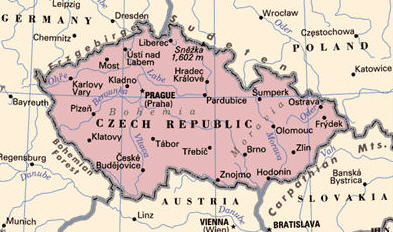
Czech
Czech (Čeština) belongs to the West Slavic group of the Slavic branch of the Indo-European language family. It is spoken by 9.2 million people in the Czech Republic. There are expatriate Czech communities in Austria, Bulgaria, Canada, Israel, Poland, Romania, 
Status
Czech is the official language of the Czech Republic. The dialect of Prague, capital of the country, forms the basis for Standard Czech. Standard Czech is the language of government administration, all levels of education, the media, and of publication. It is used alongside Common Czech, the colloquial spoken language.
Dialects
Czech has a number of mutually intelligible dialects (Ethnologue):
- Central Bohemian
- Czecho-Moravian
- Hanak
- Lach
- Northeast Bohemian
- Southwest Bohemian
There is an increasing mutual influence between Literary Czech and Common Czech, so that the main remaining differences between the two varieties now have to do with pronunciation and morphology (internal structure of words), rather than with syntax and vocabulary.
Structure
Sound system
Vowels
Czech has five vowel phonemes, i.e., sounds that differentiate word meaning. Most vowels can be either long or short. Vowel length makes a difference in the meaning of words.
| Close |
i
|
u
|
|
| Mid |
e
|
o
|
|
| Open |
a
|
Consonants
Czech allows a variety of consonant clusters. They are affected by voice assimilation, e.g., bt is pronounced as [pt], and tb is pronounced as [db] with the last consonant in the cluster determining if the whole cluster is voiceless or voiced. Voiced stops are devoiced in final position, e.g., dub ‘oak’ is pronounced as [dup]. The consonants /l/ and /r/ are syllable-forming, e.g., pln ‘full’ or prst ‘finger’. Consonants in parentheses have low frequency in the language.
|
Glottal
|
||||||||
|---|---|---|---|---|---|---|---|---|
| Stops |
voiceless
|
p
|
t
|
c
|
k
|
|||
|
voiced
|
b
|
d
|
ɟ
|
(g)
|
||||
| Fricatives |
voiceless
|
f
|
s
|
ʃ
|
x
|
|||
|
voiced
|
v
|
z
|
ʒ
|
ɦ
|
||||
| Affricates |
voiceless
|
ts
|
tʃ
|
|||||
|
voiced
|
(dz)
|
(dʒ)
|
||||||
| Nasals |
m
|
n.
|
ɲ
|
|||||
| Laterals |
l
|
|||||||
| Trill |
r, r̝
|
|||||||
| Approximants |
j
|
- /x/ = ch in Loch
- /ʃ/ =sh in shape
- /ʒ/ = s in measure
- /ɦ/ has no equivalent in English
- /tʃ/ = ch in chat
- /dʒ/ = j in jet
- /c/ = similar to t in nature
- /ɟ/ = similar to j in juice
- /ɲ/ = first n in canyon
- /r̝/ has no equivalent in English
Stress
Stress alone does not distinguish word meaning. It always falls on the first syllable of a word.
Grammar
Czech is a richly inflected synthetic language with a grammar that is very similar to that of other Slavic languages. Grammatical categories are expressed as synthetic inflections added to the stems of nouns, adjectives, verbs, and most pronouns. All native Czech stems are inflected, as well as most borrowings from other languages.
Nouns, adjectives, pronouns, and numerals
Czech nouns are marked for gender, number, and case. The three are fused into one ending, as is the case in all Slavic languages.
- There are three genders: masculine, feminine, and neuter. Each gender has its own declensional paradigm: hard (unpalatalized) stems, soft (palatalized) stems, and special types of stems.
- There are two numbers: singular, and plural, with some vestiges of the dual number.
- There are seven cases: Nominative, Genitive, Dative, Accusative, Instrumental, Locative, Vocative. Only a few nouns have retained the vocative forms;
- Masculine nouns have animate endings in the Dative, Accusative, and Locative singular, and Nominative plural.
- Adjectives agree with the nouns they modify in gender, number, and case. Like nouns, they have both hard- and soft-stem declensions.
- Pronouns use endings from noun and adjective declensions. Personal pronouns have full and short forms.
- Cardinal numerals are inflected for case. The numerals jeden ‘one’ and dva ‘two’ are also marked for gender. Ordinal numerals are declined like adjectives.
Verbs
Czech verbs have conflated endings that express person and number for non-past conjugations, and gender, number, and person for past conjugations. They agree with their subjects in person and number.
- There are three persons: first, second, third. Like all Slavic languages. Czech is a pro-drop language, i.e., personal pronouns are normally dropped because the verb ending makes the person clear. Pronouns are used only for emphatic purposes.
- There are two tenses: past, non-past. Present and future tenses have the same endings.
- Verbs have two aspects: imperfective and perfective. Perfective and imperfective verbs are formed from basic verb roots by adding prefixes and suffixes. Non-past conjugation of perfective verbs indicates future tense, non-past conjugation of imperfective verbs indicates present tense. Imperfective verbs form future tense with the auxiliary verb byt ‘be’.
- There are three moods: indicative, imperative, and conditional.
- Verbs have two voices: active, passive.
- Verbs of motion constitute a special subcategory of verbs. They are characterized by a complex system of directional and aspectual prefixes and suffixes.
Word order
The neutral word order in Czech is Subject-Verb-Object. However, other orders are possible since inflectional endings take care of clearly marking grammatical relations and roles in the sentence. Word order is principally determined by topic (what the sentence is about, or old information) and focus (new information). Constituents with old information precede constituents with new information, or those that carry the most emphasis.
Vocabulary
Most of Czech vocabulary is derived from Common Slavic roots that are shared by all Slavic languages. In addition, Czech has been influenced by a number of languages, especially Old Church Slavonic, introduced into the area by Cyril and St. Methodius in the 9th century, as well as Latin and German, the latter due to integration of Czech provinces into the Habsburg Empire.
| Hello, good day. | Dobrý den |
| Good bye | Na shledanou |
| Please | Prosím |
| Thank you. | Děkuji |
| Excuse me | S dovolením |
| I am sorry. | Promiňte |
| Yes | Ano |
| No | Ne |
| Man | Človĕk, muž |
| Woman | Žena |
Below are the Czech numerals 1-10.
|
1
|
2
|
3
|
4
|
5
|
6
|
7
|
8
|
9
|
10
|
|---|---|---|---|---|---|---|---|---|---|
|
jeden
|
dva
|
tři
|
čtyři
|
pĕt
|
šest
|
sedm
|
osm
|
devĕt
|
deset
|
Writing
Until the end of the 13th century, Czech was written with an unmodified Latin alphabet. Later, this alphabet was expanded to include digraphs and trigraphs to represent Czech sounds that were not included in the Latin alphabet. At the beginning of the 15th century, the religious reformer Jan Hus devised a writing system in which digraphs and trigraphs were replaced with diacritics over some Latin letters to indicate palatalization of consonants and length of vowels. Digraphs and letters with diacritical marks were used alongside each other for several centuries, but the diacritics prevailed in the end. The only digraph in modern Czech is ch, that represents a velar fricative (similar to that of the German [ch] of Bach). The modern Czech alphabet consists of 42 letters. It is given below.
|
A a
|
Á á
|
B b
|
C c
|
Č č
|
D d
|
Ď ď
|
E e
|
É é
|
Ĕ ĕ
|
F f
|
G g
|
H h
|
Ch ch
|
|
I i
|
Í í
|
J j
|
K k
|
L l
|
M m
|
N n
|
Ň ň
|
O o
|
P p
|
Q q
|
R r
|
Ř ř
|
S s
|
|
Š š
|
T t
|
Ť ť
|
U u
|
Ú ú
|
Ŭ ŭ
|
V v
|
W w
|
Y y
|
Ý ý
|
Z z
|
Ž ž
|
- The letters Qq and Ww are used exclusively in foreign words.
- The acute accent over vowels indicates vowel length.
- The letter Ĕĕ signals palatalization of the preceding consonant.
- The letters Úú and Ŭŭ represent the same sound: Úú is written at the beginning of words, ŭ is written elsewhere.
- The letter Cc represents the sound [ts] as in cats.
- The letter Čč represents the sound [ch] as in chat.
- The letter Žž represents the pronunciation of s in pleasure.
- The digraph ch represents the sound of ch in Loch.
- The letters Ďď, Ňň, and Ťť represent palatalized consonants.
Take a look at Article 1 of the Universal Declaration of Human Rights in Czech.
| Článek 1Všichni lidé se rodi svobodní a sobĕ rovní co do důstojnosti a práv. Jsou nadáni rozumem a svĕdomim a mají spolu jednat v duchu bratrství. |
| Article 1All human beings are born free and equal in dignity and rights. They are endowed with reason and conscience and should act towards one another in a spirit of brotherhood. |
Did You Know?
English has borrowed a few words from Czech. Here are some of them:
| robot | From the English translation of the 1920 play R.U.R., by Karel Čapek (1890-1938); from Czech robotnik ‘slave’, from robota ‘work’. |
| howitzer | From Czech houfnice ‘catapult’, introduced to Germany during the Hussite wars of the 14th century. |
| polka | From Czech polka, the dance, literally ‘Polish woman’. |
Difficulty
 How difficult is it to learn Czech? Czech is considered to be a Category II language in terms of difficulty for speakers of English.
How difficult is it to learn Czech? Czech is considered to be a Category II language in terms of difficulty for speakers of English.